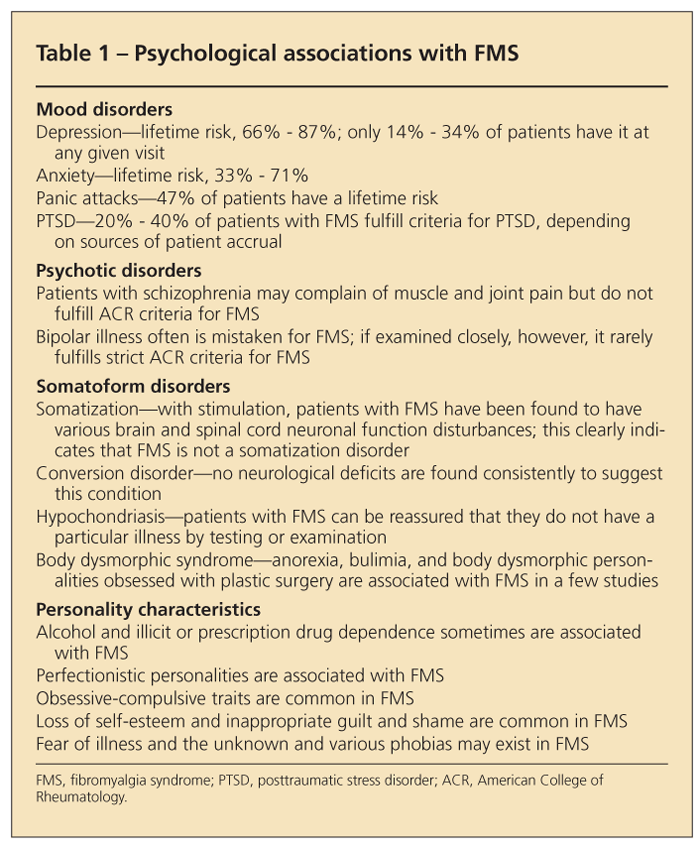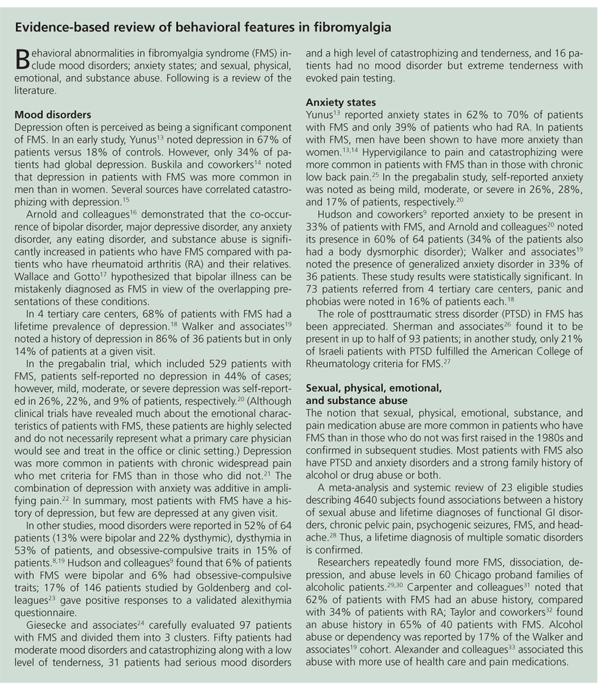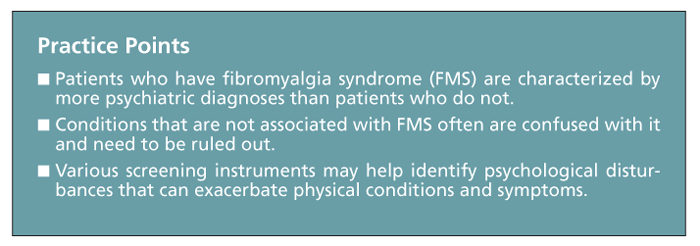Addressing behavioral abnormalities in fibromyalgia
Varying practitioner beliefs about what makes patients who have fibromyalgia syndrome (FMS) “behave” differently from the general population are complicated by a paucity of studies, heterogeneity of the patient population, and other factors.
Psychological and behavioral aberrations in fibromyalgia syndrome (FMS) have been the subject of more discourse, verbal attribution, and stigmatization than any other aspect of the condition but also of less evidence-based research. Fibromyalogists, behavioral scientists, primary care physicians, and musculoskeletal medicine–related practitioners each have their own set of seemingly firm and didactic beliefs about what makes patients who have FMS “behave” differently from the general population, and these biases are further complicated by a variety of factors.
A paucity of studies (most of which involve fewer than 100 patients) and heterogeneity of the patient population are key complicating factors. Others include the tendency of tertiary care centers to skew observational data so that it is not relevant in a primary care setting; racial, religious, socioeconomic, and ethnic diversity of patients; unstudied populations with “community” residents, or “nonpatients” (patients with FMS who are not seeking medical care); and, until recently, a lack of well-validated instruments of ascertainment. In one example of complicating biases, myofascial pain and FMS develop in many patients with scoliosis, but no suspicion that the prevalence of psychosocial distress is increased in this patient group is reported in the literature. However, psychosocial distress is highly suspected in patients in whom FMS develops after a “whiplash” injury.
For years, debate has centered on whether FMS is part of an affective spectrum disorder in which a primary psychiatric disorder with a possibly inherited abnormality leads to pain amplification and consequent neuromuscular pain or whether a biologic abnormality, such as elevated levels of substance P in cerebrospinal fluid, is the cause.1,2 The truth probably lies somewhere in between.
Many patients with FMS have no psychosocial stressors or behavioral abnormalities. Those who do tend to display more anxiety, mood disorders, and perfectionistic tendencies and to have more posttraumatic stress experiences, a history of abuse, and a loss of self-esteem. Identifying the behavioral features of patients with FMS is critical for devising a successful treatment plan. In this article, we address the behavioral mlange associated with FMS, attempt to differentiate behavioral conditions confused with it, and summarize the conclusions of the few reviews of the subject.
Terms and definitions
The most common psychological conditions associated with FMS are generalized anxiety disorder (GAD), posttraumatic stress disorder (PTSD), somatization, and mood disorders (especially depression and alexithymia)3-6:
•GAD-excessive worry and tension that is experienced for more than 6 months in association with muscle tension, easy fatigability, insomnia, irritability, and poor concentration-is manifested emotionally, cognitively, and
behaviorally.
•PTSD, an anxiety and behavioral disturbance, develops in the first month after exposure to a traumatic event, such as combat, rape, near-death experience, or a witnessed murder. It also can result from “cumulative trauma,” such as repeated physical or emotional abuse. Patients who have PTSD have flashbacks, dreams, recurrent thoughts, sympathetic nervous system activation, emotional numbing and withdrawal, nonspecific hyperarousal, and dissociation (disruption of the usually integrated function of memory, identity, or consciousness perception).
•In somatization, pathological findings do not account for bodily distress and symptoms related to it. However, the patient attributes these symptoms to the physical illness for which medical treatment is sought. Closely related are pain disorders in which pain is the predominant focus of clinical attention and psychological factors that are judged to have an important role in its onset, severity, exacerbation, or maintenance. Patients with body dysmorphic disorder have a preoccupation with an imagined defect in appearance that impairs social function. Anorexia and bulimia are included in this grouping.
•Mood disorders range from depression to mood states to bipolar states. Depression is present in most patients with FMS in their lifetime but in only 20% of patients at any physician visit.
Often, patients are depressed because they hurt. This reactive depression manifests as loss of interest or pleasure in daily activities. Classically defined as “helplessness” or “hopelessness,” it leads to a feeling of worthlessness, loss of appetite (or, occasionally, overeating), altered sleep patterns, loss of self-esteem, inability to concentrate, guilt, complaints of fatigue, and loss of energy. Patients who are depressed have lower pain thresholds, lose interest in personal care and grooming, have difficulty in making decisions, and tend to have more accidents and arguments. Depression affects the body, moods, relationships, and physical activities.
Patients with alexithymia lack the ability to describe feelings verbally. They are unable to fantasize or report multiple somatic symptoms and are quiet, pensive, agreeable, and eager to conform.
Evidence-based review

In 1980, Yunus and colleagues7 were the first to statistically correlate psychological complaints with FMS. Since that time, numerous reports have analyzed aspects of the clinical spectrum. Aaron and associates8 noted that patients with FMS were characterized by a mean of 2.8 lifetime psychiatric diagnoses listed in the Diagnostic and Statistical Manual of Mental Disorders, compared with 1.1 and 0.9 diagnoses for nonpatients and controls, respectively (Table 1). For a review of the literature, see the Box, “Evidence-based review of behavioral features in fibromyalgia,” on page S24.
Differential diagnosis
Conditions that are not associated with FMS often are confused with it.3 They need to be ruled out.
Hypochondriasis is present in persons who have an excessive fear of having a serious disease based on misinterpretation of 1 or more bodily signs or symptoms. Their fear is unrealistic and present despite reassurance. Most patients with FMS want to improve; very few display this behavioral pattern.

Persons with hysteria complain of neurological or body deficits that are not real, and they display a lack of concern about them. Criteria require a motor or sensory symptom describing a deficit (eg, “I can’t hear.” “I can’t see.” “I am paralyzed.” “There is a lump in my throat.”). This is clearly not present in FMS. There is some confusion about hysteria because it is listed in the Diagnostic and Statistical Manual of Mental Disorders as a somatoform disorder.
Usually, patients with psychogenic rheumatism are men, have severe psychological disturbances, and have complaints that satisfy a need for secondary gain or attention. Their complaints make no anatomical sense (eg, “Doc, I hurt, but only on my right side from the top of my head to the bottom of my toes.”). The confusion stems from frequent verbal description of tender points; however, there is an absence of discomfort when these areas are palpated without attention being drawn to them.
Malingering, the intentional production of false or grossly exaggerated physical or psychological symptoms, is motivated by external incentives (eg, avoiding work, obtaining financial compensation, or obtaining drugs). Usually, there is a marked discrepancy between the stress and objective findings and compliance with a physician’s recommendations is poor. Physicians have accused patients with FMS of malingering, but this is not an aspect of the syndrome.
Often, patients with bipolar illness are mistaken for those with FMS. Musculoskeletal and constitutional symptoms are features of mania and depression and may be adverse effects of many of the medications used to manage this form of psychosis. In tertiary care centers, up to 6% of self-described patients with FMS are actually bipolar.9 These persons rarely respond to an FMS treatment regimen. Similarly, patients with attention deficit disorder, substance abuse, and malnutrition may have concurrent FMS or FMS may be misdiagnosed in them.
Functional behavioral aspects
and adaptive responses
Several personality makeups are attributed to an increased predisposition toward FMS and adaptive responses that are part of the way the body reacts to pain, psychosocial stressors, and distress.10 Anxiety, found in most patients with FMS, worsens the condition. It may be manifested by shortness of breath, palpitations, dizziness, light-headedness, sweaty palms, trembling, chest pains, nausea, hot flashes and, in some extreme cases, a sense of impending doom or panic.
A subset of patients who have anxiety commonly manifest perfectionism and perfectionistic tendencies. Most are women aged 20 to 60 years who have above-average intelligence; many were premorbid overachievers. They are efficient and well groomed, they like to be organized and in control, and they often make lists. An inciting event (eg, infection, trauma, new work responsibilities, or family pressures or stresses) upsets a delicate balance.
Because they fear failure and rejection or feel guilty about increasing difficulty in maintaining their current lifestyles and activities, their mild, preexisting, chronic anxiety worsens. Sleep hygiene suffers, and musculoskeletal pain ensues. With their symptoms of anxiety, it becomes more difficult to be industrious, responsible, reliable, and functional in the quest for favorable recognition. Dysautonomia (patients are bothered by loud noises and bright lights; there are associated palpitations and dizziness) is common, and the patient often becomes hypervigilant. Anxiety increases, and pain worsens.
Loss of self-esteem in patients who ache or are tired all the time is especially common in those who also are on disability. Often, obtaining total disability is a Pyrrhic victory in that it isolates patients, diminishes socialization, and is associated with a greatly reduced income.
Patients who cannot meet educational or career goals, support themselves financially any longer, or engage in community activities are more likely to have failed relationships with family or friends and consequent loss of self-esteem than others. Usually, catastrophizing correlates with depression and is associated with poor coping strategies and decreased self-esteem.
Guilt and shame involve regretting past behavior and mistakes that may have led to FMS or decisions that led to unintended consequences. Fear stems from trauma and is especially common in patients with PTSD; it makes overcoming pain, poor sleeping patterns, and spasm more difficult. Some of these patients become falsely convinced that a single factor (eg, a virus or specific diet, life event, or genetic tendency) is solely responsible for their illness.
Anger is manifest in those who are not feeling well. This can further tighten muscles, making relaxation impossible.
Psychological evaluation

Many instruments have been used to assess the association of the symptoms in patients who have FMS with psychological aspects of their lives. These instruments include, but are not limited to, the Multidimensional Pain Inventory (MPI) (Table 2), Fibromyalgia Impact Questionnaire, and Beck Depression Inventory. Such screening measures may help identify psychological disturbances that can exacerbate physical conditions and symptoms. Clues suggesting that a complete psychological assessment is indicated include excessive pain behavior, severe emotional distress, and poor coping skills.
Turk and associates11 used the MPI to assess patients with FMS. Patient profiles were examined before therapeutic intervention to see whether a particular patient profile was associated with a better outcome.
Three MPI profiles were identified: dysfunctional (DYS), interpersonally distressed (ID), and adaptive copers (AC). Patients classified as DYS or ID had high levels of pain, poor function, and emotional disturbances. The ID patients differed from the DYS patients in that they also had very little support from their significant other. The AC patients had low levels of pain, emotional distress, and disability. Observed physical functioning (eg, flexion of the spine at the lumbar and cervical areas and straight leg raising) were impaired and did not differ between the 2 groups. The DYS and ID patients reported significantly higher levels of pain and depression than the AC patients. The ID patients had a much lower rating of their interpersonal relationship with their significant other than did patients in the other groups.

Then Turk and colleagues12 evaluated how the 3 groups responded to a standard rehabilitation protocol. The protocol consisted of an interdisciplinary treatment program with 6 half-day sessions of medication education, aerobic and stretching exercises, pacing activities and body ergonomics, and psychic pain and stress reduction management. When the group was examined as a whole for targeted variables, significant improvement was seen in targeted areas of pain severity, fatigue, depression, and sense of control; however, areas that were not addressed (eg, support from a significant other) did not improve.
When the group was evaluated for outcome based on their MPI evaluation at baseline, the ID group did not improve; the DYS group appeared to improve in all the areas. The AC group did not improve significantly, probably because they were not significantly impaired in the first place.
These results suggest that targeted intervention addressing interpersonal relationship improvement in the ID group is essential to improve the outcome in this group. The AC group probably does not benefit from the full therapy session as much as the DYS and ID groups do.
References:
References
1. Hudson JI, Hudson MS, Pliner LF, et al. Fibromyalgia and major affective disorder: a controlled phenomenology and family history study. Am J Psychiatr. 1985;142:441-446.
2. Russell IJ, Orr MD, Littman B, et al. Elevated cerebrospinal fluid levels of substance P in patients with the fibromyalgia syndrome. Arthritis Rheum. 1994;337:1593-1601.
3.Diagnosis and Statistical Manual of Mental Disorders. 4th ed. Washington, DC: American Psychiatric Association; 1995.
4. Sher L. Recognizing post-traumatic stress disorder. QJM. 2004;97:1-5.
5. Lesser IM. Current concepts in psychiatry: alexithymia. N Engl J Med. 1985;312:690-692.
6. McWhinney IR, Epstein RM, Freeman TR. Rethinking somatization. Ann Intern Med. 1997;126:747-750.
7. Yunus MB, Masi AT, Calabro JJ. Primary fibromyalgia (fibrositis): clinical study of 50 patients with matched normal controls. Semin Arthritis Rheum. 1981;11:151-171.
8. Aaron LA, Bradley LA, Alarcon GS, et al. Psychiatric diagnoses in patients with fibromyalgia are related to health care-seeking behavior rather than to illness. Arthritis Rheum. 1996;39:436-445.
9. Hudson JI, Goldenberg DL, Pope HG Jr, et al. Comorbidity of fibromyalgia with medical and psychiatric disorders. Am J Med. 1992;92:363-367.
10. Wallace DJ, Wallace JB. All About Fibromyalgia: A Guide for Patients and Their Families. Oxford, UK: Oxford University Press; 2002.
11. Turk DC, Okifuji A, Sinclair JD, Starz TW. Pain, disability and physical functioning in sub-groups of patients with fibromyalgia. J Rheumatol. 1996;23:1255-1262.
12. Turk DC, Okifuji A, Sinclair JD, Starz TW. Differential responses by psychological subgroups of fibromyalgia syndrome patients to an interdisciplinary treatment. Arthritis Care Res. 1998;111:397-404.
13. Yunus MB. Fibromyalgia syndrome: Clinical features and spectrum. J Musculoskeletal Pain. 1994;2:5-21.
14. Buskila D, Neumann L, Alhoashle A, Abu-Shakra M. Fibromyalgia syndrome in men. Semin Arthritis Rheum. 2000;30:47-51.
15. Hassett AL, Cone JD, Patella SJ, Sigal LH. The role of catastrophizing in the pain and depression of women with fibromyalgia syndrome. Arthritis Rheum. 2000;43:2493-2500.
16. Arnold LM, Hudson JI, Kck PE, et al. Comorbidity of fibromyalgia and psychiatric disorders. J Clin Psychiatry. 2006;67:1219-1225.
17. Wallace DJ, Gotto J. Hypothesis: bipolar illness with complaints of chronic musculoskeletal pain is a form of pseudofibromyalgia. Semin Arthritis Rheum. 2008;37:256-259.
18. Epstein SA, Kay G, Clauw D, et al. Psychiatric disorders in patients with fibromyalgia: a multicenter investigation. Psychosomatics. 1999;40:57-63.
19. Walker EA, Keegan D, Gardner G, et al. Psychosocial factors in fibromyalgia compared with rheumatoid arthritis, 1: psychiatric diagnoses and functional disability. Psychosom Med. 1997;59:565-571.
20. Arnold LM, Crofford LJ, Martin SA, et al. Self-reported levels of depressive and anxiety symptoms in a randomized controlled trial of patients with fibromyalgia (FM). Arthritis Rheum. 2003;48:S302.
21. White KP, Nielson WR, Harth M, et al. Chronic widespread musculoskeletal pain with or without fibromyalgia: psychological distress in a representative community adult sample. J Rheumatol. 2002;29:588-594.
22. Kurtze N, Gundersen KT, Svebak S. The role of anxiety and depression in fatigue and patterns of pain among subgroups of fibromyalgia patients. Br J Med Psychol. 1998;71:185-194.
23. Goldenberg DL, Kaplan K, Mossey CJ. Is there a specific personality trait associated with fibromyalgia. Arthritis Rheum. 1995;38:S247.
24. Giesecke T, Williams DA, Harris RE, et al. Subgrouping of fibromyalgia patients on the basis of pressure-pain thresholds and psychologic factors. Arthritis Rheum. 2003;48:2916-2922.
25. Crombez G, Eccleston C, Van den Broeck A, et al. Hypervigilance to pain in fibromyalgia: the mediating role of pain intensity and catastrophic thinking about pain. Clin J Pain. 2004;20:98-102.
26. Sherman JJ, Turk DC, Okifuji A. Prevalence and impact of posttraumatic stress disorder-like symptoms on patients with fibromyalgia syndrome. Clin J Pain. 2000;16:127-134.
27. Amir M, Kaplan Z, Neumann L, et al. Posttraumatic stress disorder, tenderness and fibromyalgia. J Psychosom Res. 1997;42:607-613.
28. Paras ML, Murad MH, Chen LP, et al. Sexual abuse and lifetime diagnosis of somatic disorders: a systematic review and meta-analysis. JAMA. 2009;302:550-561.
29. Katz RS, Kravitz HM. Fibromyalgia, depression and alcoholism: a family history study. J Rheumatol. 1996;23:149-154.
30. Leavitt F, Katz RS. The dissociative factor of symptom reports of rheumatic patients with and without fibromyalgia. J Clin Psychol Med Settings. 2003;10:259-263.
31. Carpenter MT, Hugler R, Enzenauer RJ, et al. Physical and sexual abuse in female patients with fibromyalgia. J Clin Rheumatol. 1998;4:301-306.
32. Taylor ML, Trotter DR, Csuka ME. The prevalence of sexual abuse in women with fibromyalgia. Arthritis Rheum. 1995;38:229-234.
33. Alexander RW, Bradley LA, Alarcon GS, et al. Sexual and physical abuse in women with fibromyalgia: association with outpatient health care utilization and pain medication usage. Arthritis Care Res. 1998;11:102-115.